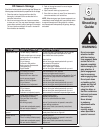
10
4
Operating
Your Tiller
WARNING
Be sure no one other
than the operator is
standing near the tiller
while starting engine
or operating the unit.
Never run engine
indoors or in enclosed,
poorly ventilated
areas. Engine exhaust
contains carbon
monoxide, an odorless
and deadly gas. Keep
hands, feet, hair and
loose clothing away
from any moving parts
on engine and tiller.
Refer to the engine
manual for detailed
instructions pertaining
to the engine controls.
Using Your Tiller
Your tiller is designed for seed bed preparation, cultivat-
ing, furrowing, and mulching.
Wheel Position
The tiller is shipped with the wheels adjusted so that the
unit sits level. The wheels need to be adjusted to meet
your tilling needs before operation. This adjustment is
made by removing the clevis pin from the wheel yoke
and raising the wheels to the desired height.
See Figure 4–3.
Tilling Depth and Wheel
Yoke Adjustment
Placement of wheel yoke will effect depth of tilling.
Yoke Forward
Place the wheel yoke so that wheels are forward (near-
est to tines) for shallow tilling, cultivating and transport.
See Figure 4–4.
Yoke to Back
Place the wheel yoke so that wheels are toward rear
(closest to depth stake) for deep tilling and cultivating.
See Figure 4–5.
Depth Stake
The depth stake acts as a brake for the tiller and
controls the depth and speed at which the machine will
operate. Remove the clevis pin and hairpin clip to raise
or lower depth stake. See Figure 4–6.
Handle Pressure
Further control of tilling depth and travel speed can be
obtained by variation of pressure on the handles.
A downward pressure on the handles will reduce the
working depth and increase the forward speed. An
upward pressure on the handles will increase the
working depth and reduce the forward speed.
The type of soil and working conditions will determine
the actual setting of the depth stake and the handle
pressure required.
Figure 4–3: Wheel and depth stake positioning.
Figure 4–6: Pivot depth stake for transportation.
Figure 4–5: Wheel and Yoke back for deeper tilling.
Figure 4–4: Wheel and Yoke forward for shallow tilling.
Transporting and
Storing the Tiller
To transport and store the tiller move the throttle to the
stop position. Pivot the depth stake away from ground up
between wheels. See Figure 4-6.


















